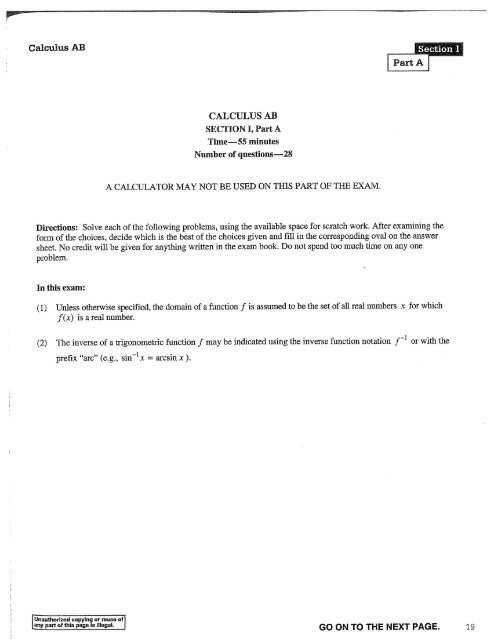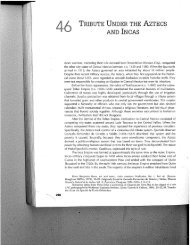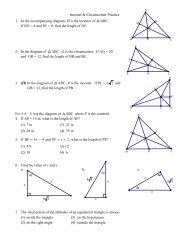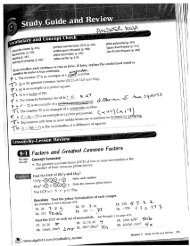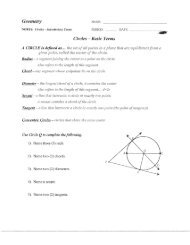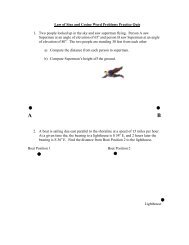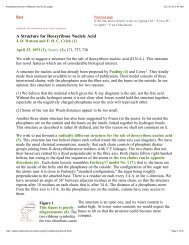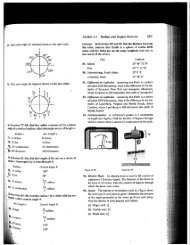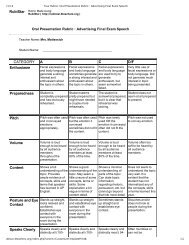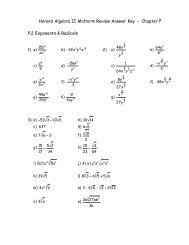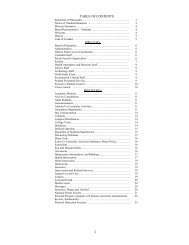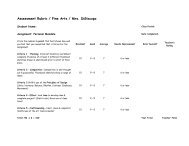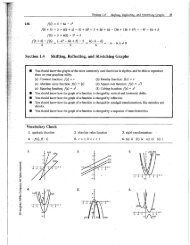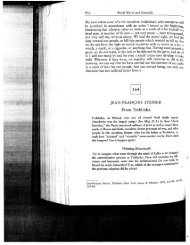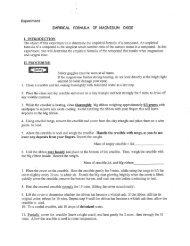a calculator may not be used on this part of the exam.
a calculator may not be used on this part of the exam.
a calculator may not be used on this part of the exam.
You also want an ePaper? Increase the reach of your titles
YUMPU automatically turns print PDFs into web optimized ePapers that Google loves.
Calculus AB<br />
CALCULUS AB<br />
SECTION I, Part A<br />
Time--55 minutes<br />
Num<str<strong>on</strong>g>be</str<strong>on</strong>g>r <strong>of</strong> questi<strong>on</strong>s--28<br />
A CALCULATOR MAY NOT BE USED ON THIS PART OF THE EXAM.<br />
Directi<strong>on</strong>s: Solve each <strong>of</strong> <strong>the</strong> following problems, using <strong>the</strong> available space for scratch work. After <strong>exam</strong>ining <strong>the</strong><br />
form <strong>of</strong> <strong>the</strong> choices, decide which is <strong>the</strong> <str<strong>on</strong>g>be</str<strong>on</strong>g>st <strong>of</strong> <strong>the</strong> choices given and fill in <strong>the</strong> corresp<strong>on</strong>ding oval <strong>on</strong> <strong>the</strong> answer<br />
sheet. No credit will <str<strong>on</strong>g>be</str<strong>on</strong>g> given for anything written in <strong>the</strong> <strong>exam</strong> book. Do <str<strong>on</strong>g>not</str<strong>on</strong>g> spend too much time <strong>on</strong> any <strong>on</strong>e<br />
problem.<br />
In <strong>this</strong> <strong>exam</strong>:<br />
(1) Unless o<strong>the</strong>rwise specified, <strong>the</strong> domain <strong>of</strong> a functi<strong>on</strong> f is assumed to <str<strong>on</strong>g>be</str<strong>on</strong>g> <strong>the</strong> set <strong>of</strong> all real num<str<strong>on</strong>g>be</str<strong>on</strong>g>rs x for which<br />
f(x) is a real num<str<strong>on</strong>g>be</str<strong>on</strong>g>r.<br />
(2) The inverse <strong>of</strong> a trig<strong>on</strong>ometric functi<strong>on</strong> f <str<strong>on</strong>g>may</str<strong>on</strong>g> <str<strong>on</strong>g>be</str<strong>on</strong>g> indicated using <strong>the</strong> inverse functi<strong>on</strong> <str<strong>on</strong>g>not</str<strong>on</strong>g>ati<strong>on</strong> f-1 or with <strong>the</strong><br />
prefix "arc" (e.g., sin-ix = arcsin x ).<br />
Unauthorized copying or muse [~.yp=,rt<strong>of</strong>t~,p,,~,,~s,~,,~. .J<br />
GO ON TO THE NEXT PAGE.
Calculus AB<br />
1.<br />
m (2x - 1)(3 - x)<br />
J~ (x - 1)(x + 3) is<br />
(A) -3 (B) -2 (C) 2 (D) 3 (E) n<strong>on</strong>existent<br />
1 dx-<br />
(A) In x 2 + C (B) -In x 2 + C (C) x-1 + C (D) -x-I + C (E) -2x-3 + C<br />
2O<br />
Unauthorized copying or muse <strong>of</strong><br />
GO ON TO THE NEXT PAGE.
Calculus AB<br />
3. If f(x) = (x- 1)(x 2 + 2) 3 , <strong>the</strong>n f’(x) =<br />
(A) 6x(x 2 + 2) 2<br />
(B) 6x(x- 1)(x2 +2)a<br />
~o) (x2 ÷ 2)2< ÷ ~x- 1)<br />
(u) -3(x- 1)(x~ + 2)~<br />
I(sin(2x) + cos(2x))ak =<br />
(A)<br />
(B)<br />
(c)<br />
cos(2x) + -~sin(2~x) 1 + C<br />
-½cos(2x) + 1 ~sin(2x) + C<br />
2cos(2x) + 2sin(2x) + C<br />
(D) 2cos(2x) - 2sin(2x) + C<br />
(B)<br />
-2cos(2x) + 2sin(2x) + C<br />
n~uihorized copying or reuse <strong>of</strong><br />
~art <strong>of</strong> <strong>this</strong> page is illegal. I<br />
GO ON TO THE NEXT PAGE.
Calculus AB<br />
lira, 5x~4 + 8x~ is<br />
x->0 3x 4 - 16x 2 5<br />
1<br />
(A) --~<br />
(B) 0 (C) 1 (D) -~ (E) n<strong>on</strong>existent<br />
{ x2-4 ifx~2<br />
f(x) = x- 2<br />
1 ifx = 2<br />
6. Let f <str<strong>on</strong>g>be</str<strong>on</strong>g> <strong>the</strong> functi<strong>on</strong> defined above. Which <strong>of</strong> <strong>the</strong> following statements about f are true?<br />
I.f has alimit at x = 2.<br />
II. f is c<strong>on</strong>tinuous at x = 2.<br />
III. f is differentiable at x = 2.<br />
(A) I <strong>on</strong>ly<br />
(B) II <strong>on</strong>ly<br />
(C) lII <strong>on</strong>ly<br />
(D) I and II <strong>on</strong>ly<br />
(E) I, II, and III<br />
22<br />
Unauthorized copying or reuse<br />
an~ pert <strong>of</strong> <strong>this</strong> page is Illegal,<br />
GO ON TO THE NEXT PAGE.
Calculus AB<br />
7. A <strong>part</strong>icle moves al<strong>on</strong>g <strong>the</strong> x-axis with velocity given by v(t) = 3t 2 + 6t for time t >_ 0. If <strong>the</strong> <strong>part</strong>icle is at<br />
positi<strong>on</strong> x = 2 at time t = 0, what is <strong>the</strong> positi<strong>on</strong> <strong>of</strong> <strong>the</strong> <strong>part</strong>icle at time t = 1 ?<br />
(A) 4 (B) 6 (C) 9 (D) 11 (E) 12<br />
8. If f(x)= cos(3x), <strong>the</strong>n f’(~) =<br />
34g (B) 45 4g (D) 3 34g<br />
(A) Z Z-<br />
(C) -Z- -~ (Z) -~-<br />
Unauthorized copying or reuse <strong>of</strong><br />
~tal r t <strong>of</strong> <strong>this</strong> page Is Illegal,<br />
GO ON TO THE NEXT PAGE. 23
Calculus AB<br />
Graph <strong>of</strong>f<br />
9. The graph <strong>of</strong> <strong>the</strong> piecewise linear functi<strong>on</strong> f is shown in <strong>the</strong> figure above. If g(x) = J_2f(t)<br />
dr,<br />
following values is greatest?<br />
(A) g(-3) (B) g(-2) (C) g(0) (D) g(1) (E) g(2)<br />
<strong>the</strong><br />
Unauthorized copying or reuse <strong>of</strong><br />
24<br />
[any <strong>part</strong> <strong>of</strong> <strong>this</strong> page is il,egaL ]<br />
GO ON TO THE NEXT PAGE.
C~lculus AB<br />
Y<br />
O 1<br />
Graph <strong>of</strong> f<br />
10. The graph <strong>of</strong> <strong>the</strong> functi<strong>on</strong> f is shown above for 0 -< x -< 3. Of <strong>the</strong> following, which has <strong>the</strong> least value?<br />
(A) I~f(x ) dx<br />
(B) Left Riemann sum approximati<strong>on</strong> <strong>of</strong> STf(x ) dx with 4 subintervals <strong>of</strong> equal length<br />
(C)<br />
Right Riemann sum approximati<strong>on</strong> <strong>of</strong> I] f(x) dx with 4 subintervals <strong>of</strong> equal length<br />
(D) Midpoint Riemann sum approximati<strong>on</strong> <strong>of</strong> f~f(x) dx with 4 subintervals <strong>of</strong> equal length<br />
(E) Trapezoidal sum approxinmti<strong>on</strong> <strong>of</strong> I~f(x ) dx with 4 subintervals <strong>of</strong> equal length<br />
U~authorlzed copying or reuse <strong>of</strong><br />
Ua~n; <strong>part</strong> <strong>of</strong> <strong>this</strong> page is glega,. I<br />
GO ON TO THE NEXT PAGE. 25
Graph <strong>of</strong> f<br />
11. The graph <strong>of</strong> a f~ncti<strong>on</strong> f is shown above. Which <strong>of</strong> <strong>the</strong> following could <str<strong>on</strong>g>be</str<strong>on</strong>g> <strong>the</strong> graph <strong>of</strong> f’, <strong>the</strong> derivative <strong>of</strong> f ?<br />
(A) Y (B) (c) Y<br />
(D) Y (E)<br />
Unauthorized copying or muse <strong>of</strong> I<br />
l"Y p~,rto, t.,. p~,. m~,g.,. I<br />
GO ON TO THE NEXT PAGe’
Calculus AB<br />
12. If f(x) = e (2Ix), <strong>the</strong>n f’(x) =<br />
(A) 2e(2/X)lnx (B) e (2/x) (E) -2x:~e (2/x)<br />
13. If f(x) = x :z + 2x, <strong>the</strong>n ~-(f(ln x)) =<br />
(A) 21nx+2 (B) 2xlnx+2x (C) 21nx+2<br />
x<br />
(D) 2In x + 2 (E) 2x +~2<br />
x<br />
x<br />
nauihor~zed copying or muse <strong>of</strong><br />
~art <strong>of</strong> <strong>this</strong> page is illegal. I<br />
GO ON TO THE NEXT PAGE.
Calculus<br />
14. The polynomial functi<strong>on</strong> f has selected values <strong>of</strong> its sec<strong>on</strong>d derivative f" given in <strong>the</strong> table above.<br />
Which <strong>of</strong> <strong>the</strong> following statements must <str<strong>on</strong>g>be</str<strong>on</strong>g> true?<br />
(A) f is increasing <strong>on</strong> <strong>the</strong> interval (0, 2).<br />
(B) f is decreasing <strong>on</strong> <strong>the</strong> interval (0, 2).<br />
(C) f has a local maximum at x = 1.<br />
(D) The graph <strong>of</strong> f has a point <strong>of</strong> inflecti<strong>on</strong> at x = 1.<br />
(E) The graph <strong>of</strong> f changes c<strong>on</strong>cavity in <strong>the</strong> interval (0, 2).<br />
(A) 4( xz -4) ~ l- C<br />
1 ~-C<br />
(B) 2(x~ _ 4 )<br />
(c) ½1nix2-4I+ C<br />
(D) 21nix 2 - 41 + C<br />
1 x<br />
(E) ~-arctm~ (~) + C<br />
I Unauthorized copying or muse <strong>of</strong><br />
GO ON TO THE NEXT PAGE,
16. If sin(xy) = x, <strong>the</strong>n dy =<br />
(A) 1<br />
(B) 1<br />
xcos(xy)<br />
(C) 1 - cos(xy)<br />
oos(xy)<br />
(D) 1- ycos(xy)<br />
xcos(xy)<br />
(E) y(1 - cos(xy))<br />
X<br />
-1<br />
1 2 3<br />
Graph <strong>of</strong> f<br />
17. The graph <strong>of</strong> <strong>the</strong> functi<strong>on</strong> f shown above has horiz<strong>on</strong>tal tangents at x = 2 and x = 5. Let g <str<strong>on</strong>g>be</str<strong>on</strong>g> <strong>the</strong> functi<strong>on</strong><br />
defined by g(x) = f£f(t)dt. For what values <strong>of</strong> x does <strong>the</strong> graph <strong>of</strong> g have a point <strong>of</strong> inflecti<strong>on</strong>?<br />
(A) 2 <strong>on</strong>ly (B) 4 <strong>on</strong>ly (C) 2 and 5 <strong>on</strong>ly (D) 2, 4, and 5 (E) 0, 4, and 6<br />
r~auihorJze~ copy ng or reuse <strong>of</strong><br />
~t <strong>of</strong> <strong>this</strong> page Is ,llegaL J<br />
GO ON TO THE NEXT PAGE. 29
Calculus<br />
18. In <strong>the</strong> xy-plane, <strong>the</strong> line x + y = k, where k is a c<strong>on</strong>stant, is tangent to <strong>the</strong> graph <strong>of</strong> y = x 2 + 3x + 1. What i<br />
<strong>the</strong> value <strong>of</strong> k ?<br />
(A) -3 (B) -2 (C) -1 (D) 0 (E) !<br />
19. What are all horiz<strong>on</strong>tal asymptotes <strong>of</strong> <strong>the</strong> graph <strong>of</strong> y = 5 + 2._...._~ x<br />
1 - 2 x in <strong>the</strong>xy-plane?<br />
(A) y =-1 <strong>on</strong>ly<br />
(B) y=0 <strong>on</strong>ly<br />
(C) y=5 <strong>on</strong>ly<br />
(D) y=-I andy=0<br />
(E) y=-I andy=5<br />
"Unr~utho~zed copying oz" muse <strong>of</strong><br />
GO ON TO THE NEXT PAGE.
Calculus AB<br />
20. Let f <str<strong>on</strong>g>be</str<strong>on</strong>g> a functi<strong>on</strong> with a sec<strong>on</strong>d derivative given by f"(x) = x 2 (x - 3)(x - 6). What are <strong>the</strong> x-coordinates<br />
<strong>of</strong> <strong>the</strong> points <strong>of</strong> inflecti<strong>on</strong> <strong>of</strong> <strong>the</strong> graph <strong>of</strong> f ?<br />
(A) 0 <strong>on</strong>ly (B) 3 <strong>on</strong>ly (C) 0 and 6 <strong>on</strong>ly (D) 3 and 6 <strong>on</strong>ly (E) 0, 3, and 6<br />
x(t)<br />
2-<br />
O<br />
4 5 6<br />
-2-<br />
21. A <strong>part</strong>icle moves al<strong>on</strong>g a straight line. The graph <strong>of</strong> <strong>the</strong> <strong>part</strong>icle’s positi<strong>on</strong> x(t) at time t is shown above for<br />
0 < t < 6. The graph has horiz<strong>on</strong>tal tangents at t = 1 and t = 5 and a point <strong>of</strong> inflecti<strong>on</strong> at t = 2. For what<br />
values <strong>of</strong> t is <strong>the</strong> velocity <strong>of</strong> <strong>the</strong> <strong>part</strong>icle increasing?<br />
(A) 0
Calculus<br />
22. A rumor spreads am<strong>on</strong>g a populati<strong>on</strong> <strong>of</strong> N people at a rate proporti<strong>on</strong>al to <strong>the</strong> product <strong>of</strong> <strong>the</strong> num<str<strong>on</strong>g>be</str<strong>on</strong>g>r <strong>of</strong> people<br />
who have heard <strong>the</strong> rumor and <strong>the</strong> num<str<strong>on</strong>g>be</str<strong>on</strong>g>r <strong>of</strong> people who have <str<strong>on</strong>g>not</str<strong>on</strong>g> heard <strong>the</strong> rumor. If p de<str<strong>on</strong>g>not</str<strong>on</strong>g>es <strong>the</strong> num<str<strong>on</strong>g>be</str<strong>on</strong>g>r <strong>of</strong><br />
people who have heard <strong>the</strong> rumor, which <strong>of</strong> <strong>the</strong> following differential equati<strong>on</strong>s could <str<strong>on</strong>g>be</str<strong>on</strong>g> <str<strong>on</strong>g>used</str<strong>on</strong>g> to model <strong>this</strong><br />
situati<strong>on</strong> with respect to time t, where k is a positive c<strong>on</strong>stant?<br />
(A) ~ = ~p<br />
dp_<br />
~B~ -~- - kp(~V - p)<br />
alp_<br />
(C) -~- - kp(p - N)<br />
dp _ kt(N - t)<br />
(D) ~--<br />
dp _ kt(t - N)<br />
(~) -~ -<br />
[ ’~authodzed copying or reuse <strong>of</strong> I<br />
32 |any<strong>part</strong><strong>of</strong>thls p..,,~, m~.~. J GO ON TO THE NEXT PA
x 2 -- with <strong>the</strong> initial<br />
23. Which <strong>of</strong> <strong>the</strong> following is <strong>the</strong> soluti<strong>on</strong> to <strong>the</strong> differential equati<strong>on</strong> ~- = Y<br />
c<strong>on</strong>diti<strong>on</strong> y(3) = -2 ?<br />
(A) y = 2e -9+x3/3<br />
(B) y =-2e -9+z3/3<br />
(C) y = 2~<br />
(D) y=U-~-14<br />
(E) y = -~2~ x3 - 14<br />
24. The functi<strong>on</strong> f is twice differentiable with f(2) = 1, f’(2) = 4, and f"(2) = 3. What is <strong>the</strong> value <strong>of</strong> <strong>the</strong><br />
approximati<strong>on</strong> <strong>of</strong> f(1.~) using <strong>the</strong> line tangent to <strong>the</strong> graph <strong>of</strong>f at x = 2 ?<br />
(A) 0.4 (B) 0.6 (C) 0.7 (D) 1.3 (E) 1.4<br />
~rlzed copying or r~use <strong>of</strong><br />
GO ON TO THE NEXT PAGE, 33
Calculus<br />
cx+d for x-2<br />
25. Let f <str<strong>on</strong>g>be</str<strong>on</strong>g> <strong>the</strong> functi<strong>on</strong> defined above, where c and d are c<strong>on</strong>stants. If f is differentiable at x = 2, what is <strong>the</strong><br />
value <strong>of</strong> c + d ?<br />
(A) -4 (B) -2 (C) 0 (D) 2 (E) 4<br />
26. What is <strong>the</strong> slope <strong>of</strong> <strong>the</strong> line tangent to <strong>the</strong> curve y = arctan (4x) at <strong>the</strong> point at which x = _1 ?<br />
4<br />
(A) 2 (B) -~ 2<br />
1<br />
(C) 0 (D)--- 2 (E) -2<br />
Unauthorized copying or muse <strong>of</strong>| ~,<br />
34 lany<strong>part</strong><strong>of</strong>tNspagelst.eg~L J<br />
GO ON TO THE NEXT PAGE.
Calculus AB<br />
Iflll<br />
IIIII<br />
IIIII<br />
/1111<br />
///11<br />
-51/i/--<br />
IIII--<br />
IIII--<br />
IIII--<br />
\~lll<br />
27. Shown above is a slope field for which <strong>of</strong> <strong>the</strong> following differential equati<strong>on</strong>s?<br />
(a) ~- - xy<br />
ay_<br />
(B) ~-- xy- y<br />
ay_<br />
(C) ~- xy+y<br />
ely<br />
(D) ~=xy+x_<br />
(z) ~ = (x +1) 3<br />
nauth0rized copying or reuse <strong>of</strong><br />
GO ON TO THE NEXT PAGE.
Calculus<br />
28. Let f <str<strong>on</strong>g>be</str<strong>on</strong>g> a differentiable functi<strong>on</strong> such that f(3) = 15, f(6) = 3, f’(3) = -8, and f’(6) = -2. The functi<strong>on</strong><br />
is differentiable and g(x) = f-1 (x) for all x. What is <strong>the</strong> value <strong>of</strong> g’(3) ?<br />
1<br />
(A) --~-<br />
(B)<br />
1<br />
1<br />
(C) ~<br />
1<br />
(D) ~<br />
(E) The value <strong>of</strong> g ’3( ) can<str<strong>on</strong>g>not</str<strong>on</strong>g> <str<strong>on</strong>g>be</str<strong>on</strong>g> determined from <strong>the</strong> informati<strong>on</strong> given.<br />
END OF PART A OF SECTION I<br />
36
CALCULUS AB<br />
SECTION I~ Part B<br />
Time--50 minutes<br />
Num<str<strong>on</strong>g>be</str<strong>on</strong>g>r <strong>of</strong> questi<strong>on</strong>s--17<br />
A GRAPI-IING CALCULATOR IS REQUIRED FOR SOME QUESTIONS ON<br />
THIS PART OF THE EXAM.<br />
Directi<strong>on</strong>s: Solve each <strong>of</strong> <strong>the</strong> following problems, using <strong>the</strong> available space for scratch work. After <strong>exam</strong>ining <strong>the</strong><br />
form <strong>of</strong> <strong>the</strong> choices, decide which is <strong>the</strong> <str<strong>on</strong>g>be</str<strong>on</strong>g>st <strong>of</strong> <strong>the</strong> choices given and fill in <strong>the</strong> corresp<strong>on</strong>ding oval <strong>on</strong> <strong>the</strong> answer<br />
sheet. No credit will <str<strong>on</strong>g>be</str<strong>on</strong>g> given for anything written in <strong>the</strong> exana book. Do <str<strong>on</strong>g>not</str<strong>on</strong>g> spend too much time <strong>on</strong> any <strong>on</strong>e<br />
problem.<br />
BE SURE YOU ARE USING PAGE 3 OF TI~ ANSWER SHEET TO RECORD YOUR ANSWERS TO<br />
QUESTIONS NUMBERED 76-92.<br />
YOU MAY NOT RETURN TO PAGE 2 OF THE ANSWER SHEET.<br />
In <strong>this</strong> <strong>exam</strong>:<br />
(1) The exact numerical value <strong>of</strong> <strong>the</strong> correct answer does <str<strong>on</strong>g>not</str<strong>on</strong>g> always appear am<strong>on</strong>g <strong>the</strong> choices given. When <strong>this</strong><br />
happens, select from am<strong>on</strong>g <strong>the</strong> choices <strong>the</strong> num<str<strong>on</strong>g>be</str<strong>on</strong>g>r that <str<strong>on</strong>g>be</str<strong>on</strong>g>st approximates <strong>the</strong> exact numerical value.<br />
(2) Unless o<strong>the</strong>rwise specified, <strong>the</strong> domain <strong>of</strong> a functi<strong>on</strong> f is assumed to <str<strong>on</strong>g>be</str<strong>on</strong>g> <strong>the</strong> set <strong>of</strong> all real num<str<strong>on</strong>g>be</str<strong>on</strong>g>rs x for which<br />
f(x) is a real num<str<strong>on</strong>g>be</str<strong>on</strong>g>r.’<br />
(3) The inverse <strong>of</strong> a trig<strong>on</strong>ometric functi<strong>on</strong> f <str<strong>on</strong>g>may</str<strong>on</strong>g> <str<strong>on</strong>g>be</str<strong>on</strong>g> indicated using <strong>the</strong> inverse functi<strong>on</strong> <str<strong>on</strong>g>not</str<strong>on</strong>g>ati<strong>on</strong> f-1 or with <strong>the</strong><br />
prefix "arc" (e.g., sin-~x = arcsin x ).<br />
~r~ <strong>of</strong> <strong>this</strong> page Is Illegal I<br />
GO ON TO THE NEXT PAGE. 37
Calculus AB<br />
Y<br />
Graph <strong>of</strong> f’<br />
76. The graph <strong>of</strong> f’; <strong>the</strong> derivative <strong>of</strong>f, is shown above for -2 < x < 5. On what intervals is f increasing?<br />
(A) [-2, 1] <strong>on</strong>ly<br />
(B) [-2, 3]<br />
(C) [3, 5] <strong>on</strong>ly<br />
(D) [0, 1.5] and [3, 5]<br />
(E) [-2, -1], [1, 2], and [4, 5]<br />
GO ON TO THE NEXT PAGE~
Calculus AB<br />
O 1 2 3 4<br />
Graph <strong>of</strong> f<br />
77. The figure above shows <strong>the</strong> graph <strong>of</strong> a functi<strong>on</strong> f with domain 0 -< x -< 4. Which <strong>of</strong> <strong>the</strong> following statements<br />
are true?<br />
I. lira f(x) exists.<br />
II. lira f(x) exists.<br />
x--~2 +<br />
III. lx~n~f(x ) exists.<br />
(A) I <strong>on</strong>ly (B) II <strong>on</strong>ly (C) I and 1I <strong>on</strong>ly (D) I and III <strong>on</strong>ly (E) I, II, and III<br />
78. The first derivative <strong>of</strong> <strong>the</strong> functi<strong>on</strong> f is defined by f’(x) = sin(x 3 - x) for 0 -< x -< 2. On what intervals<br />
is f increasing?<br />
(A) 1 < x -< 1.445 <strong>on</strong>ly<br />
(B) 1 < x -< 1.691<br />
(C) 1.445 < x -< 1.875<br />
(D) 0.577 _< x < 1.445 and 1.875 < x -< 2<br />
(E) 0
Calculus A]<br />
(A) -21 (B) -13 (C) 0 (D) 13 (E) 21<br />
80. The derivative <strong>of</strong> <strong>the</strong> functi<strong>on</strong> f is given by if(x) = x 2 cos (x 2). How many points <strong>of</strong> inflecti<strong>on</strong> does th<br />
<strong>of</strong> f have <strong>on</strong> <strong>the</strong> open interval (-2, 2) ?<br />
(A) One (B) Two (C) Three (D) Four (E) Five<br />
4O<br />
l any <strong>part</strong> <strong>of</strong> <strong>this</strong> page is illegal.<br />
GO ON TO THE NEXT PAGE. l
Calculus AB<br />
81. If G(x) is an antiderivative for f(x) and G(2) = -7, <strong>the</strong>n G(4) =<br />
(A) f’(4)<br />
(B) -7 + f’(4)<br />
(C) I:f(t ) dt<br />
(D) I:(’7 + f(t))dt<br />
(E) -7 + [?f(t)dt<br />
82. A panicle moves al<strong>on</strong>g a straight line with velocity given by v(t) = 7 - (1.01) -t~ at time t > 0. What is <strong>the</strong><br />
accelerafio6 <strong>of</strong> <strong>the</strong> panicle at time t = 3 ?<br />
(A) -0.914 (B) 0.055 (C) 5.486 (D) 6.086 (E) 18.087<br />
rlsuth~rIzed copying or reuse <strong>of</strong><br />
~<strong>of</strong> <strong>this</strong> page Is Illegal. I<br />
GO ON TO THE NEXT PAGE.<br />
4I
Calculus At<br />
83. What is <strong>the</strong> area enclosed by <strong>the</strong> curves y = x 3 - 8x 2 + 18x - 5 and y = x + 5 ?<br />
(A) 10.667 (B) 11.833 (C) 14.583 (D) 21.333 (E) 32<br />
Y<br />
5<br />
-2<br />
Graph <strong>of</strong>f ’<br />
84. The graph <strong>of</strong> <strong>the</strong> derivative <strong>of</strong> a functi<strong>on</strong> f is shown in <strong>the</strong> figure above. The graph has horiz<strong>on</strong>tal tangent lines<br />
at x = -1, x = 1, and x = 3. At which <strong>of</strong> <strong>the</strong> following values <strong>of</strong> x does f have a relative maximum?<br />
(A) -2 <strong>on</strong>ly (B) 1 <strong>on</strong>ly (C) 4 <strong>on</strong>ly (D) -I and 3 <strong>on</strong>ly (E) -2, 1, and 4<br />
I Unauthorized copying or reuse <strong>of</strong> I<br />
42 I ~’"yp"a°fthu’p~ge~’"~g’g" I GO ON TO THE NEXT F
C~lcu~us AB<br />
x -4 -3 -2 -i<br />
f(x) 0.75 -1.5 -2.25 -1.5<br />
-3 -1.5 0 1.5<br />
85. The table above gives values <strong>of</strong> a functi<strong>on</strong> f and its derivative at selected values <strong>of</strong> x. If f’ is c<strong>on</strong>tinuous <strong>on</strong> <strong>the</strong><br />
interval [-4, -1], what is <strong>the</strong> value <strong>of</strong> J:2f’(x) dx ?<br />
(A) -4.5 (B) -2.25 (C) 0 (D) 2.25 (E) 4.5<br />
naUt~orized copying or reuse <strong>of</strong><br />
GO ON TO THE NEXT PAGE. 43
Calculus<br />
0 1 2 3 4<br />
-1 2 3 0 -4<br />
86. The table gives selected values <strong>of</strong> <strong>the</strong> velocity, v(t), <strong>of</strong> a <strong>part</strong>icle moving al<strong>on</strong>g <strong>the</strong> x-axis. At time t = 0,<br />
<strong>the</strong> <strong>part</strong>icle is at <strong>the</strong> origin. Which <strong>of</strong> <strong>the</strong> following could <str<strong>on</strong>g>be</str<strong>on</strong>g> <strong>the</strong> graph <strong>of</strong> <strong>the</strong> positi<strong>on</strong>, x(t), <strong>of</strong> <strong>the</strong> <strong>part</strong>icle<br />
for 0-
Calculus AB<br />
87. An object traveling in a straight line has positi<strong>on</strong> x(t) at time t. If <strong>the</strong> initial positi<strong>on</strong> is x(0) = 2 and <strong>the</strong><br />
velocity <strong>of</strong> <strong>the</strong> object is v(t) = 31 +~-~tz, what is <strong>the</strong> positi<strong>on</strong> <strong>of</strong> <strong>the</strong> object at time t = 3 ?<br />
(A) 0.431 (B) 2.154 (C) 4.512 (D) 6.512 (E) 17.408<br />
88. The radius <strong>of</strong> a sphere is decreasing at a rate <strong>of</strong> 2 centimeters per sec<strong>on</strong>d. At <strong>the</strong> instant when <strong>the</strong> radius <strong>of</strong> <strong>the</strong><br />
sphere is 3 centimeters, what is <strong>the</strong> rate <strong>of</strong> change, in square centimeters per sec<strong>on</strong>d, <strong>of</strong> <strong>the</strong> surface area <strong>of</strong> <strong>the</strong><br />
sphere? (The surface area S <strong>of</strong> a sphere with radius r is S = 4z~r 2. )<br />
(A) -108~ (B) -72~ (C) -48x (D) -24~ (E) -16x<br />
GO ON TO THE NEXT PAGE. 45
Calculus<br />
89. The functi<strong>on</strong> f is c<strong>on</strong>tinuous for -2 < x -< 2 and f(-2) = f(2) = 0. If <strong>the</strong>re is no c, where -2 < c < 2, for<br />
which f’(c) = 0, which <strong>of</strong> <strong>the</strong> following statements must <str<strong>on</strong>g>be</str<strong>on</strong>g> true?<br />
(A) For -2 < k < 2, f’(k) > O.<br />
(B) For -2 < k < 2, f’(k) < O.<br />
(C) For -2 < k < 2, f’(k) exists.<br />
(D) For -2 < k < 2, f’(k) exists, but f’ is <str<strong>on</strong>g>not</str<strong>on</strong>g> c<strong>on</strong>tinuous.<br />
(E) For some k, where -2 < k < 2, f’(k) does <str<strong>on</strong>g>not</str<strong>on</strong>g> exist.<br />
90. The functi<strong>on</strong> f is c<strong>on</strong>tinuous <strong>on</strong> <strong>the</strong> closed interval [2, 4] and twice differentiable <strong>on</strong> <strong>the</strong> open interval (2, 4)<br />
f’(3) = 2 and f"(x) < 0 <strong>on</strong> <strong>the</strong> open interval (2, 4), which <strong>of</strong> <strong>the</strong> following could <str<strong>on</strong>g>be</str<strong>on</strong>g> a table <strong>of</strong> values for f ?<br />
(A)<br />
(D)<br />
(E)<br />
f(x)<br />
3.5<br />
3 5<br />
4 7.5<br />
I<br />
GO ON TO THE NEXT PAGE
Calculus AB<br />
¢os x<br />
91. What is <strong>the</strong> average value <strong>of</strong> y = <strong>on</strong> <strong>the</strong> closed interval [-1, 3] ?<br />
x 2 +x+2<br />
(A) -0.085 (B) 0.090 (C) 0.183 (D) 0.244 (Z) 0.732<br />
7 miles<br />
92. A city located <str<strong>on</strong>g>be</str<strong>on</strong>g>side a river has a rectangular boundary as shown in <strong>the</strong> figure above. The populati<strong>on</strong> density <strong>of</strong><br />
<strong>the</strong> city at any poiot al<strong>on</strong>g a strip x miles from <strong>the</strong> river’s edge is f(x) pers<strong>on</strong>s per square mile. Which <strong>of</strong> th<br />
following expressi<strong>on</strong>s gives <strong>the</strong> populati<strong>on</strong> <strong>of</strong> <strong>the</strong> city?<br />
(A) [£f(x) dx<br />
(B) 712f(x ) dx<br />
(C) 2812f(x ) dx<br />
~2f(x) &<br />
(E) 412/(x ) dx<br />
nsui!~)rized copying Or reuse <strong>of</strong><br />
GO ON TO THE NEXT PAGE.
Calculus AB<br />
CALCULUS AB<br />
SECTION II, Part A<br />
Time--45 minutes<br />
Num<str<strong>on</strong>g>be</str<strong>on</strong>g>r <strong>of</strong> problems--3<br />
A graphing <str<strong>on</strong>g>calculator</str<strong>on</strong>g> is required for some problems or <strong>part</strong>s <strong>of</strong> problems.<br />
1<br />
0<br />
1. Let R <str<strong>on</strong>g>be</str<strong>on</strong>g> <strong>the</strong> regi<strong>on</strong> bounded by <strong>the</strong> graphs <strong>of</strong> y = sin (a:x) and y = x 3 - 4x, as shown in <strong>the</strong> figure above.<br />
(a) Find <strong>the</strong> area <strong>of</strong> R.<br />
(b) The horiz<strong>on</strong>tal line y = -2 splits <strong>the</strong> regi<strong>on</strong> R into two <strong>part</strong>s. Write, but do <str<strong>on</strong>g>not</str<strong>on</strong>g> evaluate, an integral<br />
expressi<strong>on</strong> for <strong>the</strong> area <strong>of</strong> <strong>the</strong> <strong>part</strong> <strong>of</strong> R that is <str<strong>on</strong>g>be</str<strong>on</strong>g>low <strong>this</strong> horiz<strong>on</strong>tal line.<br />
(c) The regi<strong>on</strong> R is <strong>the</strong> base <strong>of</strong> a solid. For <strong>this</strong> solid, each cross secti<strong>on</strong> perpendicular to <strong>the</strong> x-axis is a square.<br />
Find <strong>the</strong> votume <strong>of</strong> <strong>this</strong> solid.<br />
(d) The regi<strong>on</strong> R models <strong>the</strong> surface <strong>of</strong> a small p<strong>on</strong>d. At all points in R at a distance x from <strong>the</strong> y-axis, <strong>the</strong><br />
depth <strong>of</strong> <strong>the</strong> water is given by h(x) = 3 - x. Find <strong>the</strong> volume <strong>of</strong> water in <strong>the</strong> p<strong>on</strong>d.<br />
GO ON TO THE NEXT PAGE.
Calculus<br />
t(hours) [I 0 1 ~<br />
L(t)(people) 120 156 176 [ 126 I 150~ 80 [ 0 ~<br />
2. C<strong>on</strong>cert tickets went <strong>on</strong> sale at no<strong>on</strong> (t = 0) and were sold out within 9 hours. The num<str<strong>on</strong>g>be</str<strong>on</strong>g>r <strong>of</strong> people waiting<br />
in line to purchase tickets at time t is modeled by a twice-differentiable functi<strong>on</strong> L for 0 -< t -< 9. Values<br />
<strong>of</strong> L(t) at various thnes t are shown in <strong>the</strong> table above.<br />
(a) Use <strong>the</strong> data in <strong>the</strong> table to estimate <strong>the</strong> rate at which <strong>the</strong> num<str<strong>on</strong>g>be</str<strong>on</strong>g>r <strong>of</strong> people waiting in line was changing<br />
at 5:30 P.M. (t = 5.5). Show <strong>the</strong> computati<strong>on</strong>s that lead to your answer, Indicate units <strong>of</strong> measure.<br />
(b) Use a trapezoidal sum with three subintervals to estimate <strong>the</strong> average num<str<strong>on</strong>g>be</str<strong>on</strong>g>r <strong>of</strong> people waiting in line<br />
during <strong>the</strong> first 4 hours that tickets were <strong>on</strong> sale,<br />
(c) For 0 -< t < 9, what is <strong>the</strong> fewest num<str<strong>on</strong>g>be</str<strong>on</strong>g>r <strong>of</strong> times at which L’(t) must equal 0 ? Give a reas<strong>on</strong> for your<br />
answer.<br />
(d) The rate at which tickets were sold for 0 -< t -< 9 is modeled by r(t) = 550te -t/2 tickets per hour. Based <strong>on</strong><br />
<strong>the</strong> model, how many tickets were sold by 3 P.M. (t = 3), to <strong>the</strong> nearest whole nmn<str<strong>on</strong>g>be</str<strong>on</strong>g>r?<br />
52 GO ON TO THE NEXT PAGE
~s AB Calculus AB<br />
3. Oil is leaking from a pipeline <strong>on</strong> <strong>the</strong> surface <strong>of</strong> a lake and forms an oil slick whose volume increases at a<br />
c<strong>on</strong>stant rate <strong>of</strong> 2000 cubic centimeters per minute. The oil slick takes <strong>the</strong> form <strong>of</strong> a right circular cylinder<br />
with both its radius and height changing with time. (Note: The volume V <strong>of</strong> a right circular cylinder with<br />
radius r and height h is given by V = ~r2h. )<br />
(a) At <strong>the</strong> instant when <strong>the</strong> radius <strong>of</strong> <strong>the</strong> oil slick is 100 centimeters and <strong>the</strong> height is 0.5 centimeter, <strong>the</strong> radius is<br />
increasing at <strong>the</strong> rate <strong>of</strong> 2.5 centimeters per minute. At <strong>this</strong> instant, what is <strong>the</strong> rate <strong>of</strong> change <strong>of</strong> <strong>the</strong> height o<br />
<strong>the</strong> oil slick with respect to time, in centimeters per minute?<br />
(b) A recovery device arrives <strong>on</strong> <strong>the</strong> scene and <str<strong>on</strong>g>be</str<strong>on</strong>g>gins removing oil. The rate at which oil is removed is<br />
R(t) = 400-/)- cubic centimeters per minute, where t is <strong>the</strong> time in minutes since <strong>the</strong> device <str<strong>on</strong>g>be</str<strong>on</strong>g>gan working.<br />
Oil c<strong>on</strong>tinues to leak at <strong>the</strong> rate <strong>of</strong> 2000 cubic centimeters per minute. Find <strong>the</strong> time t when <strong>the</strong> oil slick<br />
reaches its maximmn volume. Justify your answer.<br />
(c) By <strong>the</strong> time <strong>the</strong> recovery device <str<strong>on</strong>g>be</str<strong>on</strong>g>gan removing oil, 60,000 cubic centimeters <strong>of</strong> oil had already leaked.<br />
Write, but do <str<strong>on</strong>g>not</str<strong>on</strong>g> evaluate, an expressi<strong>on</strong> involving an integral that gives <strong>the</strong> volume <strong>of</strong> oil at <strong>the</strong> time found<br />
in <strong>part</strong> (b).<br />
END OF PART A OF SECTION
Calculus AB<br />
CALCULUS AB<br />
SECTION II, Part B<br />
Time--45 minutes<br />
Num<str<strong>on</strong>g>be</str<strong>on</strong>g>r <strong>of</strong> problems--3<br />
No <str<strong>on</strong>g>calculator</str<strong>on</strong>g> is allowed for <strong>the</strong>se problems°<br />
v(t)<br />
0 4<br />
Graph <strong>of</strong> v<br />
4. A <strong>part</strong>icle moves al<strong>on</strong>g <strong>the</strong> x-axis so that its velocity at time t, for 0 -< t < 6, is given by a differentiable<br />
functi<strong>on</strong> v whose graph is shown above. The velocity is 0 at t = 0, t = 3, and t = 5, and <strong>the</strong> graph has<br />
horiz<strong>on</strong>tal tangents at t = 1 and t = 4. The areas <strong>of</strong> <strong>the</strong> regi<strong>on</strong>s bounded by <strong>the</strong> t-axis and <strong>the</strong> graph <strong>of</strong> v <strong>on</strong><br />
<strong>the</strong> intervals [0, 3], [3, 5], and [5, 6] are 8, 3, and 2, respectively. At time t = 0, <strong>the</strong> <strong>part</strong>icle is at x = -2.<br />
(a) For 0 -< t < 6, find both <strong>the</strong> time and <strong>the</strong> positi<strong>on</strong> <strong>of</strong> <strong>the</strong> <strong>part</strong>icle when <strong>the</strong> <strong>part</strong>icle is far<strong>the</strong>st to <strong>the</strong> left.<br />
Justify your ~nswer.<br />
(b) For how many values <strong>of</strong> t, where 0 -< t -< 6, is <strong>the</strong> <strong>part</strong>icle at x = -8 ? Explain your reas<strong>on</strong>ing.<br />
(c) On <strong>the</strong> interval 2 < t < 3, is <strong>the</strong> speed <strong>of</strong> <strong>the</strong> <strong>part</strong>icle increasing or decreasing? Give a reas<strong>on</strong> for your<br />
answer.<br />
(d) During what time intervals, if any, is <strong>the</strong> accelerati<strong>on</strong> <strong>of</strong> <strong>the</strong> <strong>part</strong>icle negative? Justify your answer.<br />
54<br />
GO ON TO THE NEXT PAGI
Calculus AB<br />
5. C<strong>on</strong>sider <strong>the</strong> differential equati<strong>on</strong> dYdx = "~’ where x ~: 0.<br />
(a) On <strong>the</strong> axes provided, sketch a slope field for <strong>the</strong> given differential equati<strong>on</strong> at <strong>the</strong> nine points indicated.<br />
(Note: Use <strong>the</strong> axes provided in <strong>the</strong> <strong>exam</strong> booklet.)<br />
Y<br />
0<br />
(b) Find <strong>the</strong> <strong>part</strong>icular soluti<strong>on</strong> y = f(x) to <strong>the</strong> differential equati<strong>on</strong> with <strong>the</strong> initial c<strong>on</strong>diti<strong>on</strong> f(2) = O.<br />
(c) For <strong>the</strong> <strong>part</strong>icular soluti<strong>on</strong> y = f(x) descri<str<strong>on</strong>g>be</str<strong>on</strong>g>d in <strong>part</strong> (b), find lim f(x).<br />
6. Let f <str<strong>on</strong>g>be</str<strong>on</strong>g> <strong>the</strong> functi<strong>on</strong> given by f(x) = ln~x for all x > 0. The derivative <strong>of</strong> f is given by f’(x) = 1 - In x<br />
x x 2<br />
(a) Write an equati<strong>on</strong>, for <strong>the</strong> line tangent to <strong>the</strong> graph <strong>of</strong> f at x = e 2.<br />
(b) Find <strong>the</strong> x-coordinate <strong>of</strong> <strong>the</strong> critical point <strong>of</strong> f. Determine whe<strong>the</strong>r <strong>this</strong> point is a relative minimum, a relative<br />
maximum, or nei<strong>the</strong>r for <strong>the</strong> functi<strong>on</strong> f. Justify your answer.<br />
(c) The graph <strong>of</strong> <strong>the</strong> functi<strong>on</strong> f has exactly <strong>on</strong>e point <strong>of</strong> inflecti<strong>on</strong>. Find <strong>the</strong> x-coordinate <strong>of</strong> <strong>this</strong> point.<br />
(d) Find lim f(x).<br />
x--~0 +<br />
END OF EXAM


